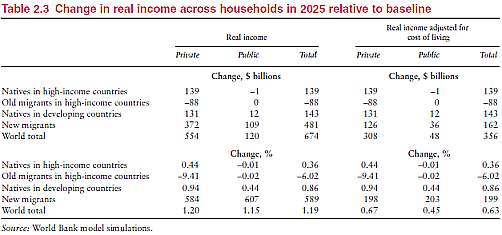World Bank: immigration would increase global income $356 billion by 2025; see what they won't highlight
A 2005 report by the World Bank made the claim that increasing migration from low-income countries to high-income countries enough to increase the labor force in high-income countries by 3% would result in raising global incomes $356 billion by 2025. Press release at [1], report link at [2].
Since promoters of the study won't highlight another figure from the study, take a look at the chart (from [2]) below. Notice anything a bit disconcerting?
Yes, that's right: those gains come at the great expense of "Old migrants in high-income countries".
They claim that "Natives in high-income countries" would see income gains adjusted for cost of living of $139 billion but at the same time, those "old migrants" would see their incomes drop by $88 billion. So, by their own figures, the net gain to high-income countries would just be around $50 billion by 2025. That's just 3% of *current* U.S. GDP, and would probably be around 2.5% of a projected 2025 U.S. GDP [3]. And, all of that wouldn't happen in the U.S.: presumably the World Bank would like Europe to continue experiencing the wonders of massive immigration as well. So, the U.S. gains might be as little as 1 or 2% of the 2025 GDP.
Now see immigration economics: this is right in line with those other studies. They're no doubt ignoring some fiscal costs of this increased immigration and they're definitely ignoring the non-fiscal costs: reducing the voting power of the native-born, increased risks of terrorism, increasing power for racial demagogues, increasing social welfare costs for those "old migrants", increased crimes committed by those "old migrants", social unrest (justifiable, depending on how expressed) by those "old migrants", and so on. The World Bank would have the U.S. greatly hurt one part of its population in order to help people who don't even live in the U.S.
---------------------
[1]
web.worldbank.org/WBSITE/EXTERNAL/NEWS/
0,,contentMDK:20724214~pagePK:64257043~piPK:437376~theSitePK:4607,00.html
International migration can generate substantial welfare gains for migrants and their families, as well as their origin and destination countries, if policies to better manage the flow of migrants and facilitate the transfer of remittances are pursued, says the World Bank's annual Global Economic Prospects (GEP) report for 2006.
"With the number of migrants worldwide now reaching almost 200 million, their productivity and earnings are a powerful force for poverty reduction,” said François Bourguignon, World Bank Chief Economist and Senior Vice President for Development Economics. "Remittances, in particular, are an important way out of extreme poverty for a large number of people. The challenge facing policymakers is to fully achieve the potential economic benefits of migration, while managing the associated social and political implications.”
...Turning to the main theme of this year's GEP, remittances and migration, the report presents evidence that an increase in migrants that would raise the work force in high-income countries by three percent by 2025 could increase global real income by 0.6 percent, or $356 billion. Such an increase in migrant stock would be in line with the migration trend observed during the past three decades.
[2]
www-wds.worldbank.org/external/default/WDSContentServer/IW3P/IB/2005/11/14/
000112742_20051114174928/additional/841401968_2005103190201050.pdf
[3] A projected GDP of $19.4 trillion is here:
ers.usda.gov/data/macroeconomics/Data/ProjectedRealGDPValues.xls



